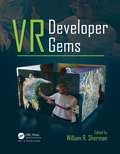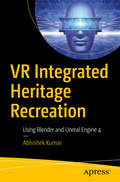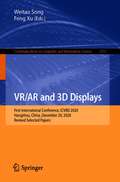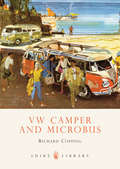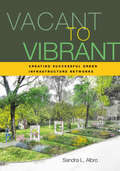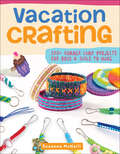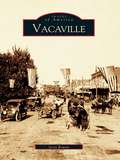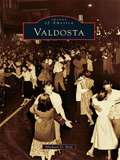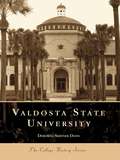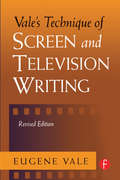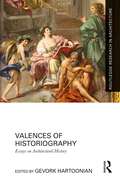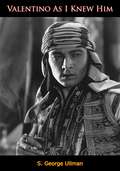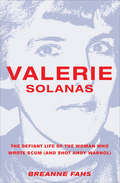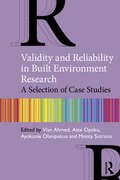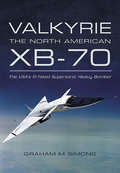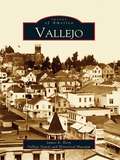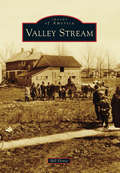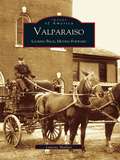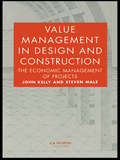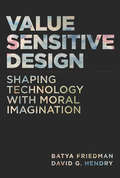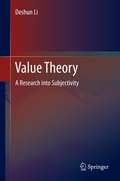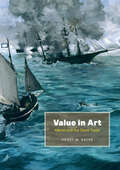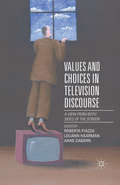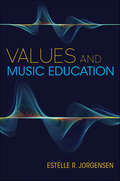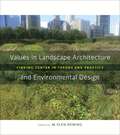- Table View
- List View
VR Developer Gems
by William R. ShermanThis book takes the practicality of other "Gems" series such as "Graphics Gems" and "Game Programming Gems" and provide a quick reference for novice and expert programmers alike to swiftly track down a solution to a task needed for their VR project. Reading the book from cover to cover is not the expected use case, but being familiar with the territory from the Introduction and then jumping to the needed explanations is how the book will mostly be used. Each chapter (other than Introduction) will contain between 5 to 10 "tips", each of which is a self-contained explanation with implementation detail generally demonstrated as pseudo code, or in cases where it makes sense, actual code. Key Features Sections written by veteran virtual reality researchers and developers Usable code snipits that readers can put to immediate use in their own projects. Tips of value both to readers entering the field as well as those looking for solutions that expand their repertoire.
VR Integrated Heritage Recreation: Using Blender and Unreal Engine 4
by Abhishek KumarCreate assets for history-based games. This book covers the fundamental principles required to understand and create architectural visualizations of historical locations using digital tools. You will explore aspects of 3D design visualization and VR integration using industry-preferred software. Some of the most popular video games in recent years have historical settings (Age of Empires, Call of Duty, etc.). Creating these games requires creating historically accurate game assets. You will use Blender to create VR-ready assets by modeling and unwrapping them. And you will use Substance Painter to texture the assets that you create.You will also learn how to use the Quixel Megascans library to acquire and implement physically accurate materials in the scenes. Finally, you will import the assets into Unreal Engine 4 and recreate a VR integrated heritage that can be explored in real time. Using VR technology and game engines, you can digitally recreate historical settings for games.What You Will LearnCreate high-quality, optimized models suitable for any 3D game engineMaster the techniques of texturing assets using Substance Painter and Quixel MegascansKeep assets historically accurateIntegrate assets with the game engineCreate visualizations with Unreal Engine 4Who Is This Book ForGame developers with some experience who are eager to get into VR-based games
VR/AR and 3D Displays: First International Conference, ICVRD 2020, Hangzhou, China, December 20, 2020, Revised Selected Papers (Communications in Computer and Information Science #1313)
by Feng Xu Weitao SongThis book constitutes selected and revised papers from the First International Conference on VR/AR and 3D Displays, ICVRD 2020, held in Hangzhou, China, in December 2020.The 12 full papers presented were thoroughly reviewed and selected from 29 submissions. The papers present recent serearch on virtual reality, augmented reality, 3D displays and related topics, including but not limited to human-computer interaction, near-eye displays, naked eye 3D displays, modeling, simulation, animation, and applications.
VW Camper and Microbus
by Richard CoppingThe Volkswagen Transporter is one of the best-loved and most recognisable motor vehicles of all time. The preferred transport for surfers and hippies everywhere, the Volkswagen Type 2 'bus' was born in 1950, the first of a new breed of vehicle, the ancestor of today's people carrier. Available in various versions, including panel van, pick up and minibus, Transporters were often converted into campervans for a newly motorised class of holidaymaker. This book looks at the development, production and use of the class first, and second, generation Transporter. With archive illustrations including many colour photographs from old brochures this book is also a great evocation of the 1950s and 60s.From the Trade Paperback edition.
Vacant to Vibrant: Creating Successful Green Infrastructure Networks
by Sandra AlbroVacant lots, so often seen as neighborhood blight, have the potential to be a key element of community revitalization. As manufacturing cities reinvent themselves after decades of lost jobs and population, abundant vacant land resources and interest in green infrastructure are expanding opportunities for community and environmental resilience. Vacant to Vibrant explains how inexpensive green infrastructure projects can reduce stormwater runoff and pollution, and provide neighborhood amenities, especially in areas with little or no access to existing green space.Sandra Albro offers practical insights through her experience leading the five-year Vacant to Vibrant project, which piloted the creation of green infrastructure networks in Gary, Indiana; Cleveland, Ohio; and Buffalo, New York. Vacant to Vibrant provides a point of comparison among the three cities as they adapt old systems to new, green technology. An overview of the larger economic and social dynamics in play throughout the Rust Belt region establishes context for the promise of green infrastructure. Albro then offers lessons learned from the Vacant to Vibrant project, including planning, design, community engagement, implementation, and maintenance successes and challenges. An appendix shows designs and plans that can be adapted to small vacant lots.Landscape architects and other professionals whose work involves urban greening will learn new approaches for creating infrastructure networks and facilitating more equitable access to green space.
Vacation Crafting: 150+ Summer Camp Projects for Boys & Girls to Make (BigFoot Search and Find)
by Suzanne McNeillGet crafty wherever you go with this treasure trove of fun, family-friendly projects from friendship bracelets to tie-dye, bead crafts, and much more! Inspired by the classic crafts of summer camp, Vacation Crafting provides more than one hundred fifty child-friendly projects for girls and boys ages 4 to 12. Kids will learn to make friendship bracelets, woven potholders, pony bead animals, plastic lanyards, wire art, rubber band jewelry, foam crafts, scoubidou, paracord gear, and more. Using inexpensive, readily available craft supplies that are easy to take along to the mountains or beach, the crafting projects featured in this volume are the perfect activity for any family vacation. They are also a sure way to liven up parties, scout meetings, rainy days, and after-school activities. Color photos, supply lists, easy-to-follow instructions, and patterns make it easy to supervise the fun.
Vacaville
by Jerry BowenVacaville, named for its founder, Juan Manual Vaca, grew up next to what has become a major highway to Sacramento and points north. It became famous for its Nut Tree Restaurant, which for decades offered travelers the produce of this fertile fruit-growing region. Now the modern highway bypasses Vacaville's historic downtown, leaving it to be enjoyed by the growing population of greater Vaca Valley. Even though the modern city has grown out to engulf that new highway and an ever more diversified economy continues to thrive, old Vacaville still feels and looks like a small town of another era. Unscathed by earthquake since 1892, enlightened city officials have not only preserved much of the original downtown but have added a "Creekwalk" that gives an air of quiet greenery.
Valdosta
by Michael O. HoltValdosta, located in Lowndes County in the wiregrass region of southern Georgia, was founded in 1860, when the county seat was moved 4 miles east from Troupville to meet the railroad that would connect the region with Savannah. The town was named for the residence of former governor George Troup, who named his home after the Valle d'Aosta region of northern Italy. The town took some time to begin substantial growth, but after the Sea Island cotton market boomed in the late 1800s, the town entered a period of expansion that has rarely slowed. Currently, Valdosta is home to several major highways, a state university, a nationally known amusement park, and an Air Force base.
Valdosta State University
by Deborah Skinner DavisIn January of 1913, South Georgia State Normal College opened in Valdosta, Georgia, with three students who paid $10 a year for tuition and $12 per month for food and board. Colonel W.S. West donated land for the campus to the state, the Georgia Senate allocated $25,000 to the school, the city of Valdosta raised $50,000, and Richard Holmes Powell was chosen as the school's first president. From this early ambitious endeavor to educate the traditionally underserved students of South Georgia grew a college that has served not only as an institution of higher learning but also as a valuable resource for citizens all over the region. Known as Georgia State Womens College (1992-1950) and Valdosta State College (1950-1993), Valdosta State University boasts a long and distinguished history. What was once a training school for teachers now offers a wide variety of undergraduate programs and awards masters and several doctorate degrees. Within these pages, the colorful characters, cherished traditions, memorable social and sporting events, and picturesque campus of VSU are all brought to life. Photographs taken from the Valdosta State University Archives date back to the school's beginnings, before the student body became co-educational. View the early May Queens and their courts parading on school grounds and the Old English Christmas Feast; step back to the days when men first arrived on campus, bringing a variety of new social, civic, and athletic organizations with them; and discover the remarkable beauty of the school's Spanish Mission-style campus.
Vale's Technique of Screen and Television Writing
by Eugene ValeVale's Technique of Screen and Television Writing is an updated and expanded edition of a valuable guide to writing for film and television. Mr. Vale takes the aspiring writer through every phase of a film's development, from the original concept to the final shooting script. Teachers of the craft as well as writers and directors have acclaimed it as one of the best books ever written on how to write a screenplay. This book combines practical advice for the aspiring or established writer with a lucid overview of the unique features of this most contemporary art form, distinguishing film and video from other media and other kinds of storytelling. It teaches the reader to think in terms of the camera and gives practical advice on the realities of filmmaking. At the same time, Vale, who began his own career as a scriptwriter for the great French director Jean Renoir, provides a solid grounding in the history of drama from the Classical Greek theater through the great cinematic works of the twentieth century. Both philosophical and pragmatic, this is a very readable book for students and active professionals who want to improve their writing skills, and for film enthusiasts interested in knowing more about what they see on the screen.Mr. Vale is that rare combination, a practitioner of great experience who can offer a lucid explanation of his craft.Eugene Vale was born in Switzerland and began his career in France in the 1930s. He was an award-winning novelist, film and TV scriptwriter and teacher, whose works include the bestselling novel The Thirteenth Apostle and the scripts for Francis of Assisi, The Bridge of San Luis Rey, and The Second Face. He also worked in many other areas of the motion picture industry, including directing, producing, cutting, distribution and finance. His archives are held by Boston University and University of Southern California. Mr. Vale died in 1997, shortly after he completed the updated version of this handbook.
Valences of Historiography: Essays on Architectural History (Routledge Research in Architecture)
by Gevork HartoonianThe compiled essays offer various themes and ways of approaching historiography. Each chapter probes the state of contemporary theorization of architecture histories, working toward the theme of critically re-writing history. Essential to each author's contribution are specific traditions created by the mole of history burrowing through the past. This book concerns the historian's conjectures towards capturing the past and present zeitgeist.Temporality is the theme running through the narrative of this volume. It raises the question of whether the ever-growing body of work on architectural history should be considered as history. More specifically, what is the intersection between history and architectural history? Furthermore, can every text focused on architecture's past be considered categorically historiographic? In what capacity does architectural history index history beyond contingencies and without reducing the text to empirical realities and the historian's interest in a specific subject, including those collected through archival research, itself an emblem of textuality? This book upholds the conviction that the past should be recalled accurately and that there is no history but historical criticism, the scope of which exceeds the historicity of Humanism. Dialectically, the timeline experienced across contemporary techno-economic and cultural domains (aesthetics) offers an opportunity to explore architecture produced outside the Euro-American continents.Valences of Historiography offers a fresh take on architectural history that is useful for academics, researchers and architecture students.
Valentino As I Knew Him: As I Knew Him (classic Reprint)
by O. O. Macintyre S. George UllmanRudolph Valentino (1895-1926) was an early pop icon and a sex symbol of the 1920s, having starred in several well-known silent films including The Four Horsemen of the Apocalypse, The Sheik, Blood and Sand, The Eagle, and The Son of the Sheik, and he became known as the “Latin lover” or simply “Valentino.” His sudden death at just 31 years of age unleashed mass hysteria among his female fans and further propelled him into iconic status.This biography of the famous Italian actor, which was originally published in 1926, not long after his untimely death, was written by his business manager and closest friend, George Ullman, providing with the reader with a unique insight into the icon’s life.
Valerie Solanas: The Defiant Life of the Woman Who Wrote Scum (and Shot Andy Warhol)
by Breanne FahsThe authoritative biography of the 60s countercultural icon who wrote SCUM Manifesto, shot Andy Warhol, and made an unforgettable mark on feminist history. Valerie Solanas is one of the most polarizing figures of 1960s counterculture. A cult hero to some and vehemently denounced by others, she has been dismissed but never forgotten. Known for shooting Andy Warhol in 1968 and for writing the infamous SCUM Manifesto, Solanas became one of the most famous women of her era. But she was also diagnosed with paranoid schizophrenia and spent much of her life homeless or in mental hospitals. Solanas&’s SCUM Manifesto, a sui generis vision of radical gender dystopia, predicted ATMs, test-tube babies, the Internet, and artificial insemination long before they existed. It has sold more copies and been translated into more languages than nearly all other feminist texts of its time. And yet, shockingly little work has investigated the life of its author. This book is the first biography about Solanas, including original interviews with family, friends (and enemies), and numerous living Warhol associates. It reveals surprising details about Solanas&’s life: the children nearly no one knew she had, her drive for control over her own writing, and her elusive personal and professional relationships. Valerie Solanas reveals the tragic, remarkable life of an iconic figure. It is &“not only a remarkable biographical feat but also a delicate navigation of an unwieldy, demanding, and complex life story&” (BOMB Magazine).
Validity and Reliability in Built Environment Research: A Selection of Case Studies
by Vian AhmedThis book aims to guide researchers who are engaged in social science and built environment research through the process of testing the reliability and validity of their research outputs following the application of different methods of data collection. The book presents case studies that emphasize reliability and validity in different examples of qualitative, quantitative and mixed method data sets, as well as covering action research and grounded theory. The reader is guided through case studies that demonstrate: An understanding of the reliability and validity approaches from social science and built environment perspectives in alignment with the relevant research philosophies, approaches and data collection strategies Real research projects that have been conducted by expert researchers on topics such as Lean, BIM, Housing and Sustainability to answer specific or evolving questions in relation to the reliability and validity of research A simple and easy method that students at Masters and PhD levels can relate to in order to adopt a sound reliability and validity approach to their research This book is the essential guide for researchers at undergraduate and postgraduate level who need to understand how to validate the quality of the empirical tests they conduct using different techniques. The book will also be a great asset to supervisors from different backgrounds who need a refresher on this key aspect of the research cycle.
Valkyrie: The USA's Ill-fated Supersonic Heavy Bomber
by Graham M. SimonsDuring the 1950s, at the time Elvis Presley was rocking the world with Hound Dog and the USA was aiming to become the worlds only superpower, plans were being drawn at North American Aviation in Southern California for an incredible Mach-3 strategic bomber. The concept was born as a result of General Curtis LeMays desire for a heavy bomber with the weapon load and range of the subsonic B-52 and a top speed in excess of the supersonic medium bomber, the B-58 Hustler. If LeMays plans came to fruition there would be 250 Valkyries in the air; it would be the pinnacle of his quest for the ultimate strategic bomber operated by Americas Strategic Air Command. The design was a leap into the future that pushed the envelope in terms of exotic materials, avionics and power plants. However, in April 1961, Defense Secretary McNamara stopped the production go-ahead for the B-70 because of rapid cost escalation and the USSRs newfound ability to destroy aircraft at extremely high altitude using either missiles or the new Mig-25 fighter. Nevertheless, in 1963 plans for the production of three high-speed research aircraft were approved and construction proceeded. In September 1964 the first Valkyrie, now re-coded A/V-1 took to the air for the first time and in October went supersonic.This book is the most detailed description of the design, engineering and research that went into this astounding aircraft. It is full of unpublished details, photographs and firsthand accounts from those closely associated with the project. Although never put into full production, this giant six-engined aircraft became famous for its breakthrough technology, and the spectacular images captured on a fatal air-to-air photo shoot when an observing Starfighter collided with Valkyrie A/V-2 which crashed into the Mojave Desert.The loss of the $750 million aircraft and two lives stopped future development, although there were several attempts to redesign it as an airliner to compete against the European Concorde.
Vallejo
by James E. Kern Vallejo Naval and Historical MuseumFounded as California's state capital in 1850 and named for one of the state's pre-eminent native sons, General Mariano Vallejo, the city of Vallejo has a favored location on the eastern interior of San Francisco Bay. Protected from wind, fog, and possible invasion by sea, Mare Island, just off Vallejo's shoreline, was the United States Navy's first base in the Pacific in 1854. Mare Island Navy Yard grew to meet the challenge of every major conflict in the country, reaching its apex during World War II and ending its military life producing nuclear submarines. The sunny sloping streets of Vallejo lengthened and became more populous in tandem with the Yard, expanding in bursts and nearly tripling its population in the 1940s. In recent years the city and its institutions have survived a wrenching urban and economic redevelopment process, now building on the creative strengths of its historic downtown and colorfully diverse population to forge a Vallejo for the new millennium.
Valley Stream (Images of America)
by Bill FlorioLocated near the south shore of Long Island at the gateway to Nassau County, the village of Valley Stream has grown from a bucolic farming community in the 1840s to a dense suburban hub full of history and diversity. Consisting of communities named Foster's Meadow, Rum Junction, Skunk's Misery, and Hungry Harbor, the town saw nightlife and leisure blossom after Merrick Road was built and the South Side Railroad pulled in. The village incorporated in 1925, finding itself a center of industry as the location of the Ridgewood Reservoir's conduit pipe, Curtiss Field, Bulova Demco, and later, the birthplace of Snapple. Over the years, Valley Stream gained attention through many of its attractions, including the William R. Gibson Houses, Hoffman's, the Pavilion Royal, Green Acres Mall, the Rio Theatre, Valley Stream State Park, and Itgen's Ice Cream Parlour.
Valparaiso: Looking Back, Moving Forward
by Lanette MullinsThe rich history of Valparaiso spans centuries. Originally home to the Potawatomi Indians, the area was a centralized meeting place for many Native American tribes. The land was sold to the U.S. in 1832, and in 1836, Porter County was formed when the area was separated from LaPorte County. The new county was named in honor of Comdr. David Porter, who played a significant role in the War of 1812 at the Battle of Valparaiso, Chile. The county seat was named Portersville. In 1837, Portersville was proudly renamed Valparaiso, which literally means "vale of paradise," to further honor Commodore Porter. In Valparaiso, Indiana: Looking Back, Moving Forward author Lanette Mullins chronicles the history and development of the city, with its small-town charm, in over 200 vintage images. The book features photographs of the historic homes that grace the city streets, the famous individuals who walked them, the influential history of Valparaiso University, and the cultural institutions throughout the city.
Value Management in Design and Construction
by John Kelly Steven MaleThis book looks at the transfer and further development of value management procedures, as practised in North America, in a United Kingdom and Commonwealth construction industry context.
Value Sensitive Design: Shaping Technology with Moral Imagination
by Batya Friedman David G. HendryUsing our moral and technical imaginations to create responsible innovations: theory, method, and applications for value sensitive design. Implantable medical devices and human dignity. Private and secure access to information. Engineering projects that transform the Earth. Multigenerational information systems for international justice. How should designers, engineers, architects, policy makers, and others design such technology? Who should be involved and what values are implicated? In Value Sensitive Design, Batya Friedman and David Hendry describe how both moral and technical imagination can be brought to bear on the design of technology. With value sensitive design, under development for more than two decades, Friedman and Hendry bring together theory, methods, and applications for a design process that engages human values at every stage. After presenting the theoretical foundations of value sensitive design, which lead to a deep rethinking of technical design, Friedman and Hendry explain seventeen methods, including stakeholder analysis, value scenarios, and multilifespan timelines. Following this, experts from ten application domains report on value sensitive design practice. Finally, Friedman and Hendry explore such open questions as the need for deeper investigation of indirect stakeholders and further method development. This definitive account of the state of the art in value sensitive design is an essential resource for designers and researchers working in academia and industry, students in design and computer science, and anyone working at the intersection of technology and society.
Value Theory: A Research into Subjectivity
by Deshun LiHumankind's progress has always been driven by two momentums: the pursuit of truth and the creation of value. But our understanding of value, and our ability to reflect on its complexity, has long lagged behind our constant search for truth. This has, in turn limited our grasp of the essence of truth. This book takes philosophical contemplations on value to a new level, while also explicating some contemporary Chinese styles of philosophical thought. Over the past 25 years, this book has been having an increasing impact on Chinese readers and researchers, and it also provides a good platform for international dialogue on several key issues of philosophical studies.
Value in Art: Manet and the Slave Trade
by Henry M. SayreArt historian Henry M. Sayre traces the origins of the term “value” in art criticism, revealing the politics that define Manet’s art. How did art critics come to speak of light and dark as, respectively, “high in value” and “low in value”? Henry M. Sayre traces the origin of this usage to one of art history’s most famous and racially charged paintings, Édouard Manet’s Olympia. Art critics once described light and dark in painting in terms of musical metaphor—higher and lower tones, notes, and scales. Sayre shows that it was Émile Zola who introduced the new “law of values” in an 1867 essay on Manet. Unpacking the intricate contexts of Zola’s essay and of several related paintings by Manet, Sayre argues that Zola’s usage of value was intentionally double coded—an economic metaphor for the political economy of slavery. In Manet’s painting, Olympia and her maid represent objects of exchange, a commentary on the French Empire’s complicity in the ongoing slave trade in the Americas. Expertly researched and argued, this bold study reveals the extraordinary weight of history and politics that Manet’s painting bears. Locating the presence of slavery at modernism’s roots, Value in Art is a surprising and necessary intervention in our understanding of art history.
Values and Choices in Television Discourse: A View from Both Sides of the Screen
by Roberta Piazza Louann Haarman Anne CabornThe high-pressured, fast-paced environment of television production leaves little time for producers to reflect on how the potentialities of texts and images will be interpreted outside of the immediate broadcast imperatives. This volume brings together the producers and analysts of television in a formal and productive way.
Values and Music Education (Counterpoints: Music and Education)
by Estelle R. JorgensenWhat values should form the foundation of music education? And once we decide on those values, how do we ensure we are acting on them?In Values and Music Education, esteemed author Estelle R. Jorgensen explores how values apply to the practice of music education. We may declare values, but they can be hard to see in action. Jorgensen examines nine quartets of related values and offers readers a roadmap for thinking constructively and critically about the values they hold. In doing so, she takes a broad view of both music and education while drawing on a wide sweep of multidisciplinary literature. Not only does Jorgensen demonstrate an analytical and dialectical philosophical approach to examining values, but she also seeks to show how theoretical and practical issues are interconnected.An important addition to the field of music education, Values and Music Education highlights values that have been forgotten or marginalized, underscores those that seem perennial, and illustrates how values can be double-edged swords.
Values in Landscape Architecture and Environmental Design: Finding Center in Theory and Practice (Reading the American Landscape)
by M. Elen DemingThe successful realization of diversity, resilience, usefulness, profitability, or beauty in landscape design requires a firm understanding of the stakeholders' values. This collection, which incorporates a wide variety of geographic locations and cultural perspectives, reinforces the necessity for clear and articulate comprehension of the many factors that guide the design process. As the contributors to this collection reveal, dominant and emerging social, political, philosophical, and economic concerns perpetually assert themselves in designed landscapes, from manifestations of class consciousness in Napa Valley vineyards to recurring themes and conflicts in American commemorative culture as seen in designs for national memorials. One essay demonstrates the lasting impact of the doctrine of Manifest Destiny on the culture and spaces of the Midwest, while another considers the shifting historical narratives that led to the de-domestication and subsequent re-wilding of the Oostvaardersplassen in the Netherlands. These eleven essays help foster the ability to conduct a balanced analysis of various value systems and produce a lucid visualization of the necessary tradeoffs. Offering an array of case studies and theoretical arguments, Values in Landscape Architecture and Environmental Design encourages professionals and educators to bring self-awareness, precision, and accountability to their consideration of landscape designs.
